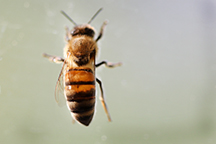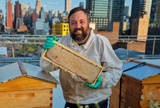Rising CO2 Levels Reduce Protein in Crucial Pollen Source for Bees

WEST LAFAYETTE, Ind. – Rising levels of atmospheric carbon dioxide have reduced protein in goldenrod pollen, a key late-season food source for North American bees, a Purdue University study shows.
Researchers found that the overall protein concentration of goldenrod pollen fell about one-third from the onset of the Industrial Revolution to the beginning of the 21st century.
Previous studies have shown that increases in carbon dioxide can lower the nutritional value of plants such as wheat and rice – staple crops for much of the global human population – but this study is the first to examine the effects of rising CO2 on the diet of bees.
“Bee food is less nutritious than it used to be,” said Jeffrey Dukes, study co-author and professor of forestry and natural resources and biological sciences. “Our findings also suggest that the quality of pollen will continue to decline into the future. That’s not great news for bees.”
Native bee species and honeybees rely on flowering plants for energy and nutrition. While nectar is the primary energy source for bee colonies, pollen is the sole source of protein for bees. Pollen is essential for the development of bee larvae and helps maintain bees’ immunity to pathogens and parasites.
Goldenrod, a common North American perennial that blooms from late July through October, offers bees some of the last available pollen before winter. Bees that overwinter must store substantial amounts of pollen to rear their winter young. Declines in pollen protein could potentially threaten bee health and survival and weaken bees’ ability to overwinter on a continental scale, said Jeffery Pettis, study co-author and research entomologist with the U.S. Department of Agriculture’s Agricultural Research Service.
“A poor diet sets bees up for failure,” he said. “Previous research shows bees have shorter lifespans when fed lower quality pollen.”
The researchers noted, however, that this study only assessed pollen protein levels and did not look at the impact of protein reductions on bee health and populations.
“Our work suggests there is a strong possibility that decreases in pollen protein could contribute to declines in bee health, but we haven’t yet made that final link,” said Dukes, who is also director of the Purdue Climate Change Research Center housed in Discovery Park.
Dukes collaborated with a team led by USDA-ARS researchers to examine protein levels in historical and experimental samples of goldenrod pollen. They found that pollen protein levels dropped about a third in samples collected from 1842-2014, a period during which the amount of carbon dioxide in the Earth’s atmosphere rose from about 280 parts per million to 398 ppm. The greatest drop in protein occurred during 1960-2014, a time when atmospheric carbon dioxide levels rose dramatically.
A 2-year controlled field experiment that exposed goldenrod to a gradient of carbon dioxide levels from 280 to 500 ppm showed strikingly similar decreases in pollen protein, Dukes said.
“These data provide an urgent and compelling case for establishing CO2 sensitivity of pollen protein for other floral species,” the researchers concluded in their study.
Bees provide a valuable service to U.S. agriculture through pollination, contributing more than $15 billion in added crop value each year.
But a number of new and mounting pressures are crippling colonies and endangering bee populations. These threats include emerging diseases and parasites such as deformed wing virus, Varroa mites and Nosema fungi; a lack of diversity and availability of pollen and nectar sources; and exposure to a wide variety of pesticides. From 2006 to 2011, annual losses of managed honeybee colonies averaged about 33 percent per year, according to the USDA-ARS.
“Bees already face a lot of factors that are making their lives hard,” Dukes said. “A decline in the nutritional quality of their food source going into a critical season is another reason to be concerned.”
Elevated levels of atmospheric carbon dioxide – a building block for plant sugars -have allowed many plants to grow faster and bigger. But this growth spurt can dilute plants’ total protein, rather than concentrating it in the grain, resulting in a less nutritious food source.
Slowing the degrading effects of rising carbon dioxide levels on plant nutrition hinges on reducing carbon emission rates from deforestation and burning fossil fuels, Dukes said.
“The impact of carbon emissions on the nutritional value of our food supply is something people need to be aware of. This issue isn’t just relevant to honeybees and people – it will probably affect thousands or even millions of other plant-eating species around the world. We don’t yet know how they’ll deal with it.”
The study was published in Proceedings of the Royal Society B on Wednesday (April 13) and is available to journal subscribers and on-campus readers at http://dx.doi.org/10.1098/rspb.2016.0414.
Researchers from Williams College, the Smithsonian Institution and the University of Maryland also co-authored the study.
The work was funded by the USDA-ARS.
Article from Bee Culture, Catch the Buzz
Recent Posts
-
Unleashing the Sweet Potential: A Comprehensive Guide to Honey Marketing
Introduction: In the buzzing world of beekeeping, producing high-quality honey is just the beginnin …May 17th 2024 -
Beekeeper in the Big Apple
Home to the busiest streets in America, cars lined bumper to bumper, herds of young professionals ma …Sep 28th 2022 -
Robbing Honeybees: Detection and Prevention
As a beekeeper, it is important to be able to understand what robbing is and how to recognize …Sep 22nd 2022




